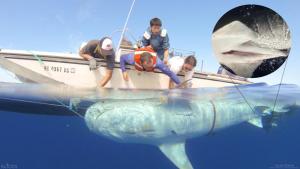UH Researchers Tag More Tiger Sharks for Online Tracking

Shark biology: Male sharks showed signs of mating abrasions on their pelvic claspers (shown inset). Photo credit: Mark Royer University of Hawaiʻi at Mānoa, Hawaiʻi Institute of Marine Biology.
By Wendy Osher
A total of 14 tiger sharks are now being tracked via satellite transmitters as researchers round out phase two of a project to observe their movement in Maui waters.
The study comes following an “uptick in the number of shark attacks reported on Maui,” including two fatalities last year, according to information released today by the University of Hawaiʻi at Mānoa’s Hawaiʻi Institute of Marine Biology.
The Pacific Islands Ocean Observing System is monitoring the near-real-time movement online as part of a $186,000, two-year study funded by the state Department of Land and Natural Resources. The results will be used to “guide future decisions regarding management of shark populations in the state.”

Tagged tiger shark swimming away. Photo credit: Mark Royer University of Hawaiʻi at Mānoa, Hawaiʻi Institute of Marine Biology.
The data will also be used to study tiger shark movements including whether sharks around Maui are more resident than they are around other islands, and whether they exhibit greater use of inshore habitats than in other locations, according to information posted on the web tracking page.
The latest tracking effort was led by UH scientists Carl Meyer and Kim Holland who tagged six sharks in January, 2014, in addition to the eight that were tagged in October of 2013.
“The most recent tagging trip off Maui was timed to coincide with the tiger shark mating season, a time of year when large males are easier to catch,” according to the UH announcement, noting all six “bore fresh mating scars.”
“As part of the study, researchers hope to determine whether major biological events such as pupping and mating draw tiger sharks to Maui, and whether those sharks leave afterwards,” according to a University press release.
So far, 11 of the 14 sharks that have satellite tracking were viewable on the website this morning, including 9 females and 2 males ranging in size from 9.3 to 14.2 feet.
According to UH researchers, rough seas, limited satellite coverage, and surface time of sharks may all impact the online tracking, which needs enough dry time on the tag to get a clean location fix.








